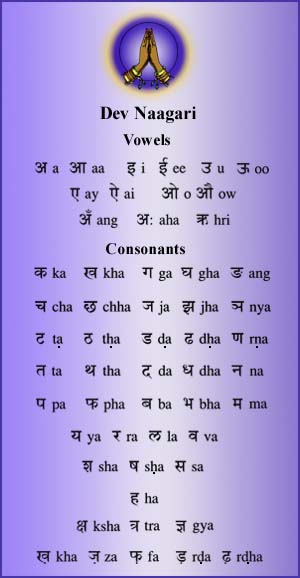Special features of Hindi Language Classes
Hindi is an Indo-Aryan language and is a direct descendant of Sanskrit (The Classical Language of India). It is a very expressive language. In poetry and songs, it can convey emotions using simple and gentle words. It can also be used for exact and rational reasoning. It has been influenced and enriched by Dravidian, Turkish, Farsi, Arabic, Portuguese, and English. Hindi is ranked among the 4 most widely spoken languages of the world. More than 500 million people speak Hindi, as their first or second language all over the world!
Hindi is written in the Devanagari script. Devanagari is pronounced as it is written. This makes it quite easy to learn. The script is written from left to right and has no capital letters. Hindi is a phonetic language, meaning that the way a word is spelled corresponds to the way it is pronounced, and vice versa. So you don't find words like knife, with its mysteriously silent k, in Hindi.
Special Symbols
Vowel suppressor: called virama, this symbol is used to suppress the inherent vowel of a syllable.
Nasalization marker: there is usually at least one symbol which indicates nasalization of vowels or other sounds. In Devanagari, the anusvara and the chandrabindu play that role.
Breath marker: the visarga indicates that a sound has a breathy quality.
Hindi script originated (and is still the same) as ancient Sanskrit. The DevNagari script is also common to several other Indian languages. The use of the special symbols varies widely from one language to another.
Our program
is specifically designed for kids with NO previous formal Hindi instruction. Integration of English phonic sounds into Devanagari (Hindi) script, visual materials, flashcards, and verbal techniques make it easy and interesting, for all age groups. Equal emphasis is paid to conversation skills and written script practice. Lessons progress depending on the age and level of each student.
Cultural enrichment is interwoven in each class to expose the Indian American student to the rich and diverse heritage. History, Geography, and social aspects are introduced through maps, quizzes, games, and interactive share days. The curriculum is based on the Indian Board system, with suitable elements added or deleted to meet the requirements of students here.
Dialects of Hindi:
Marwari Braj, Bundeli, Kanauji, Chattisgarhi, Bagheli, Avadhi, Bhojpuri, and many others. It is not easy to delimit the the borders of the Hindi-speaking region. Sometimes they are regarded to be independent languages and sometimes dialects of Hindi. A 1997 survey found that 66% of all indians can speak Hindi, and 77% of indians regard Hindi as "one language across the nation".
Evening & Weekend class schedule
Monday-3:30PM Monday-5:30PM
Tuesday-5:30PM Tuesday-7:00PM (pvt.)
Wednesday-5:30PM
Friday-5:30PM Friday-7:00PM (pvt.)
Saturday-11:30PM Saturday-5:00PM
Sunday-11:30AM Sunday-1:00pm (pvt.) Sunday-3:15PM
Morning session available for preschoolers and pre-kindergartners on request.

